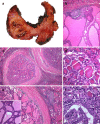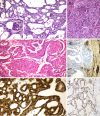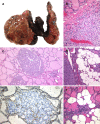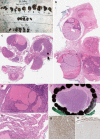Inherited Follicular Epithelial-Derived Thyroid Carcinomas: From Molecular Biology to Histological Correlates
- PMID: 33495912
- PMCID: PMC7960606
- DOI: 10.1007/s12022-020-09661-y
Inherited Follicular Epithelial-Derived Thyroid Carcinomas: From Molecular Biology to Histological Correlates
Abstract
Cancer derived from thyroid follicular epithelial cells is common; it represents the most common endocrine malignancy. The molecular features of sporadic tumors have been clarified in the past decade. However the incidence of familial disease has not been emphasized and is often overlooked in routine practice. A careful clinical documentation of family history or familial syndromes that can be associated with thyroid disease can help identify germline susceptibility-driven thyroid neoplasia. In this review, we summarize a large body of information about both syndromic and non-syndromic familial thyroid carcinomas. A significant number of patients with inherited non-medullary thyroid carcinomas manifest disease that appears to be sporadic disease even in some syndromic cases. The cytomorphology of the tumor(s), molecular immunohistochemistry, the findings in the non-tumorous thyroid parenchyma and other associated lesions may provide insight into the underlying syndromic disorder. However, the increasing evidence of familial predisposition to non-syndromic thyroid cancers is raising questions about the importance of genetics and epigenetics. What appears to be "sporadic" is becoming less often truly so and more often an opportunity to identify and understand novel genetic variants that underlie tumorigenesis. Pathologists must be aware of the unusual morphologic features that should prompt germline screening. Therefore, recognition of harbingers of specific germline susceptibility syndromes can assist in providing information to facilitate early detection to prevent aggressive disease.
Keywords: APC; Carney complex; Cowden syndrome; Cribriform-morular thyroid carcinoma; DICER1; DICER1 syndrome; FAP; Familial non-medullary thyroid carcinoma; PRKAR1A; PTEN; PTEN-hamartoma tumor syndrome; RASAL1; SDHB; Thyroid cancer; WRN; Wermer syndrome.
Conflict of interest statement
The authors declare that they have no conflict of interest.
Figures





Similar articles
-
Hereditary and familial thyroid tumours.Histopathology. 2018 Jan;72(1):70-81. doi: 10.1111/his.13373. Histopathology. 2018. PMID: 29239041 Review.
-
Familial thyroid cancer: a review.Mod Pathol. 2011 Apr;24 Suppl 2:S19-33. doi: 10.1038/modpathol.2010.147. Mod Pathol. 2011. PMID: 21455198 Review.
-
Familial follicular cell tumors: classification and morphological characteristics.Endocr Pathol. 2010 Dec;21(4):219-26. doi: 10.1007/s12022-010-9135-6. Endocr Pathol. 2010. PMID: 20878367 Review.
-
Thyroid cancer of follicular cell origin in inherited tumor syndromes.Adv Anat Pathol. 2010 Nov;17(6):428-36. doi: 10.1097/PAP.0b013e3181f8b028. Adv Anat Pathol. 2010. PMID: 20966648 Review.
-
Genomics and Epigenomics of Medullary Thyroid Carcinoma: From Sporadic Disease to Familial Manifestations.Endocr Pathol. 2021 Mar;32(1):35-43. doi: 10.1007/s12022-021-09664-3. Epub 2021 Jan 25. Endocr Pathol. 2021. PMID: 33492588 Free PMC article. Review.
Cited by
-
Management of follicular thyroid carcinoma.Eur Thyroid J. 2024 Oct 16;13(5):e240146. doi: 10.1530/ETJ-24-0146. Print 2024 Oct 1. Eur Thyroid J. 2024. PMID: 39419099 Free PMC article. Review.
-
Folliculin (FLCN) in Thyroid Tumors: Incidence, Significance, and Role as a Driver Gene and Secondary Alteration.Curr Oncol. 2025 Apr 11;32(4):224. doi: 10.3390/curroncol32040224. Curr Oncol. 2025. PMID: 40277780 Free PMC article.
-
Ultrasound-Histopathological Presentation of Thyroid and Ovary Lesions in Adolescent Patients with DICER1 Syndrome: Case Reports and Literature Overview.Children (Basel). 2024 Mar 28;11(4):403. doi: 10.3390/children11040403. Children (Basel). 2024. PMID: 38671620 Free PMC article.
-
Expanding Our Knowledge of DICER1 Gene Alterations and Their Role in Thyroid Diseases.Cancers (Basel). 2024 Jan 13;16(2):347. doi: 10.3390/cancers16020347. Cancers (Basel). 2024. PMID: 38254836 Free PMC article. Review.
-
Overview of the 2022 WHO Classification of Familial Endocrine Tumor Syndromes.Endocr Pathol. 2022 Mar;33(1):197-227. doi: 10.1007/s12022-022-09705-5. Epub 2022 Mar 13. Endocr Pathol. 2022. PMID: 35285003 Review.
References
-
- Maxwell EL, Hall FT, Freeman JL. Familial non-medullary thyroid cancer: a matched-case control study. Laryngoscope. 2004;114(12):2182–2186. - PubMed
-
- Charkes ND. On the prevalence of familial nonmedullary thyroid cancer in multiply affected kindreds. Thyroid. 2006;16(2):181–186. - PubMed
-
- Sippel RS, Caron NR, Clark OH. An evidence-based approach to familial nonmedullary thyroid cancer: screening, clinical management, and follow-up. World J Surg. 2007;31(5):924–933. - PubMed
-
- Ito Y, Kakudo K, Hirokawa M, Fukushima M, Yabuta T, Tomoda C, Inoue H, Kihara M, Higashiyama T, Uruno T, Takamura Y, Miya A, Kobayashi K, Matsuzuka F, Miyauchi A. Biological behavior and prognosis of familial papillary thyroid carcinoma. Surgery. 2009;145(1):100–105. - PubMed
Publication types
MeSH terms
Supplementary concepts
LinkOut - more resources
Full Text Sources
Other Literature Sources
Medical
Research Materials
Miscellaneous

